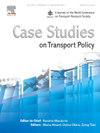Braving the elements: A time series analysis of e-scooter ridership assessing the impact of weather and seasonality across different climate regions
IF 2.4
Q3 TRANSPORTATION
引用次数: 0
Abstract
The introduction of e-scooters sharing schemes represents the latest phase in the diversification of micromobility in urban environments. Municipal authorities in the United States have led the way with piloting e-scooters sharing schemes to consider how they are used and the impacts this has for the wider transport system. This paper reports a time series econometric analysis of the trip data derived from e-scooter pilots in Minneapolis, Louisville, and Austin which represent a climate gradient down the central United States. The analysis evaluates the link between ridership and prevailing weather conditions such as temperature, wind speed, precipitation alongside weather events such as thunder and fog. An autoregressive distributed lag model format is applied at both daily and hourly aggregations of e-scooter demand with specific attention paid to how consistent these models are across the three pilots.
The results indicate that demand in the subtropical climate of Austin is quite stable throughout the year while ridership in the more northern climes of Louisville and Minneapolis follows a seasonal profile of being high in summer and dropping off during winters. The parameters calculated for the meteorological elements for daily ridership are stable across the pilots, indicating that user response to weather conditions is reasonably consistent in different climates. Riders in Austin appear more willing to displace trips to attain better weather conditions, bringing trips forward when the temperatures are hotter and postponing trips when it is windy or raining. Hourly ridership models are less stable in terms of their results and require more focused research to further reveal their dynamics. Practical implications of these studies are that cities considering the introduction of e-scooter sharing schemes would benefit from examining demand patterns in similar climate regions to plan for suitable scales and seasonal operations.
勇敢面对各种因素:对不同气候地区的电动滑板车乘客进行时间序列分析,评估天气和季节性的影响
电动滑板车共享计划的引入代表了城市环境中微型交通多样化的最新阶段。美国市政当局率先试点了电动滑板车共享计划,以考虑它们的使用方式及其对更广泛的交通系统的影响。本文对明尼阿波利斯、路易斯维尔和奥斯汀的电动滑板车驾驶员的出行数据进行了时间序列计量分析,这三个城市代表了美国中部的气候梯度。该分析评估了客流量与气温、风速、降水以及雷电和大雾等天气状况之间的联系。在每日和每小时的电动滑板车需求汇总中应用自回归分布滞后模型格式,并特别注意这些模型在三个试点中的一致性。结果表明,在亚热带气候的奥斯汀,全年的需求相当稳定,而在北部气候的路易斯维尔和明尼阿波利斯,客流量遵循夏季高,冬季低的季节性特征。为日常乘客计算的气象要素参数在不同的飞行员中是稳定的,这表明用户对天气条件的反应在不同的气候条件下是相当一致的。奥斯汀的乘客似乎更愿意为了获得更好的天气条件而提前出行,在气温较高的时候提前出行,在刮风或下雨的时候推迟出行。按小时计费模式的结果不太稳定,需要更集中的研究来进一步揭示其动态。这些研究的实际意义是,考虑引入电动滑板车共享计划的城市将受益于检查类似气候区域的需求模式,以规划合适的规模和季节性运营。
本文章由计算机程序翻译,如有差异,请以英文原文为准。
求助全文
约1分钟内获得全文
求助全文

 求助内容:
求助内容: 应助结果提醒方式:
应助结果提醒方式:


